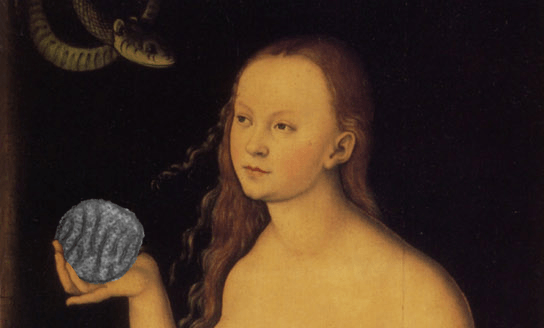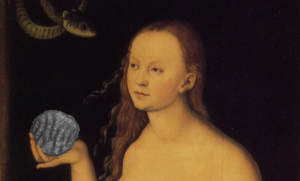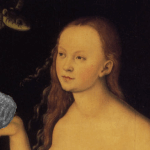
The theory of Mitochondrial Eve is based on the exclusivity of human mitochondrial DNA inheritance to the female line, which when traced would lead to only one most recent woman, “Eve”. (Image credit: Ludela, Creative Commons Attribution-Share Alike 3.0 Unported)
Table of Contents
If one wants to trace down lineage, that person could turn to the cell’s powerhouse, the mitochondrion. This organelle contains its own special set of DNA believed as inherited solely from mothers across generations. Thus, looking at the mitochondrial DNA (by mtDNA genealogical DNA testing) could help track down lineage, and for this reason, help determine ancestral or familial connection. Recently though, a team of scientists reported that the mitochondrial DNA is not solely inherited from the mothers. New empirical evidence of biparental inheritance of mitochondrial DNA implicates the need to rectify the long-held notion that the inheritance of mitochondrial genome is exclusively matrilineal or female line.
Mitochondrial DNA
The mitochondrion (plural: mitochondria), reckoned as the powerhouse of the cell, generates metabolic energy, especially the form of adenosine triphosphate (ATP). And it does so through the process referred to as cellular respiration. Apart from that, the organelle is also described as semi-autonomous since it has its own genetic material distinct from that found in the nucleus. The nucleus contains more genes organized into chromosomes and in charge for almost all of the metabolic processes in the body. On the contrary, the genetic material in the mitochondrion – referred to as mitochondrial DNA – is relatively fewer in number. It carries the genetic code for the manufacturing of RNAs and proteins necessary to the various functions of the mitochondrion, such as energy production.
(Recent news on the evolutionary origin of mitochondria, read: Prokaryotic Ancestor of Mitochondria: on the hunt)
(You may also want to read: Mitochondrial DNA – hallmark of psychological stress)
Mitochondrial inheritance
In humans, the mitochondrial DNA is believed to be inherited solely from the mother. This notion stems from the events that happen at fertilization. The sperm contains on its neck a helix of mitochondria that power up the tail to swim toward the ovum. And when the sperm finally makes its way into the ovum, it leaves its neck and tail on the cell surface of the ovum. Mitochondria that are brought into the ovum would eventually be inactivated and disintegrated. Thus, the mitochondria in the ovum are the only ones that the zygote eventually inherits. A human ovum has an average of 200,000 mtDNA molecules.1 For this, certain traits and diseases involving mitochondrional DNA implicate maternal origin.
Inheritance of mtDNA – not exclusive
The theory of Mitochondrial Eve holds that tracing the matrilineal lineage of all recent human beings would lead to all lines converging to one woman referred to as “Eve“. The theory is based on the exclusivity of human mitochondrial DNA inheritance to female line. Nevertheless, independent empirical findings and clinical studies challenge this precept.
For instance, Schwartz and Vissing2 reported the case of a 28-year-old man with mitochondrial myopathy. Accordingly, the patient had a mutation (a novel 2-bp mtDNA deletion in ND2 gene). Normally, the gene encodes for a subunit of the enzyme complex I of the mitochondrial respiratory chain. Thus, the faulty gene affected the production of such enzyme, which, in turn, led to the patient’s severe, lifelong exercise intolerance. Furhter, Schwartz and Vissing2 pointed out that the patient’s mitochondrial myopathy was paternal in origin.
Recently, a team of researchers observed paternal inheritance of mitochondrial DNA, but this time, on 17 people from three different families.3 They sequenced their mitochondrial DNAs and they discovered father-to-offspring transmission.
Conclusion
The mitochondrial DNA is said to be a mother’s legacy to her offspring. However, recent studies indicate that the father could also transmit it to his progeny. Somehow, paternal DNA from mitochondria gets into the ovum. Rather than disintegrated or inactivated, it gets expressed. Mitochondrial DNA from the fathers may not be as rare as once thought. If more studies will corroborate soon, this could debunk Mitochondrial Eve theory. It might also render mtDNA genealogical DNA testing questionable. And, we may also need to start looking to the other side of our lineage to fathom hereditary diseases arising from faulty mitochondrial DNA.
— written by Maria Victoria Gonzaga
References
1 Mitochondrial DNA. (2018). Biology-Online Dictionary. Retrieved from https://www.biologyonline.com/dictionary/mitochondrial-DNA
2 Schwartz, M. & Vissing, J. (2002). “Paternal Inheritance of Mitochondrial DNA”. New England Journal of Medicine. 347 (8): 576–580.
3 Luo, S., Valencia, C.A., Zhang, J., Lee, N., Slone, J., Gui, B., Wang, X., Li, Z., Dell, S., Brown, J., Chen, S.M., Chien, Y., Hwu, W., Fan, P., Wong, L., Atwal, P.S., & Huang, T. (2018). Biparental Inheritance of Mitochondrial DNA in Humans. Proceedings of the National Academy of Sciences 201810946. DOI:10.1073/pnas.1810946115

